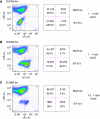Targeting ErbB2 and ErbB3 with a bispecific single-chain Fv enhances targeting selectivity and induces a therapeutic effect in vitro
- PMID: 18841159
- PMCID: PMC2576487
- DOI: 10.1038/sj.bjc.6604700
Targeting ErbB2 and ErbB3 with a bispecific single-chain Fv enhances targeting selectivity and induces a therapeutic effect in vitro
Abstract
Inappropriate signalling through the EGFR and ErbB2/HER2 members of the epidermal growth factor family of receptor tyrosine kinases is well recognised as being causally linked to a variety of cancers. Consequently, monoclonal antibodies specific for these receptors have become increasingly important components of effective treatment strategies for cancer. Increasing evidence suggests that ErbB3 plays a critical role in cancer progression and resistance to therapy. We hypothesised that co-targeting the preferred ErbB2/ErbB3 heterodimer with a bispecific single-chain Fv (bs-scFv) antibody would promote increased targeting selectivity over antibodies specific for a single tumour-associated antigen (TAA). In addition, we hypothesised that targeting this important heterodimer could induce a therapeutic effect. Here, we describe the construction and evaluation of the A5-linker-ML3.9 bs-scFv (ALM), an anti-ErbB3/ErbB2 bs-scFv. The A5-linker-ML3.9 bs-scFv exhibits selective targeting of tumour cells in vitro and in vivo that co-express the two target antigens over tumour cells that express only one target antigen or normal cells that express low levels of both antigens. The A5-linker-ML3.9 bs-scFv also exhibits significantly greater in vivo targeting of ErbB2'+'/ErbB3'+' tumours than derivative molecules that contain only one functional arm targeting ErbB2 or ErbB3. Binding of ALM to ErbB2'+'/ErbB3'+' cells mediates inhibition of tumour cell growth in vitro by effectively targeting the therapeutic anti-ErbB3 A5 scFv. This suggests both that ALM could provide the basis for an effective therapeutic agent and that engineered antibodies selected to co-target critical functional pairs of TAAs can enhance the targeting specificity and efficacy of antibody-based cancer therapeutics.
Figures





Similar articles
-
Antitumor activity of a novel bispecific antibody that targets the ErbB2/ErbB3 oncogenic unit and inhibits heregulin-induced activation of ErbB3.Mol Cancer Ther. 2012 Mar;11(3):582-93. doi: 10.1158/1535-7163.MCT-11-0820. Epub 2012 Jan 16. Mol Cancer Ther. 2012. PMID: 22248472
-
Isolation and characterization of an anti-CD16 single-chain Fv fragment and construction of an anti-HER2/neu/anti-CD16 bispecific scFv that triggers CD16-dependent tumor cytolysis.Mol Immunol. 1999 May;36(7):433-45. doi: 10.1016/s0161-5890(99)00057-7. Mol Immunol. 1999. PMID: 10449096
-
Combining anti-ERBB3 antibodies specific for domain I and domain III enhances the anti-tumor activity over the individual monoclonal antibodies.PLoS One. 2014 Nov 11;9(11):e112376. doi: 10.1371/journal.pone.0112376. eCollection 2014. PLoS One. 2014. PMID: 25386657 Free PMC article.
-
ERBB3/HER3 and ERBB2/HER2 duet in mammary development and breast cancer.J Mammary Gland Biol Neoplasia. 2008 Jun;13(2):215-23. doi: 10.1007/s10911-008-9083-7. Epub 2008 May 3. J Mammary Gland Biol Neoplasia. 2008. PMID: 18454306 Free PMC article. Review.
-
Novel anticancer targets: revisiting ERBB2 and discovering ERBB3.Nat Rev Cancer. 2009 Jul;9(7):463-75. doi: 10.1038/nrc2656. Epub 2009 Jun 18. Nat Rev Cancer. 2009. PMID: 19536107 Review.
Cited by
-
Imaging of HER3-expressing xenografts in mice using a (99m)Tc(CO) 3-HEHEHE-Z HER3:08699 affibody molecule.Eur J Nucl Med Mol Imaging. 2014 Jul;41(7):1450-9. doi: 10.1007/s00259-014-2733-7. Epub 2014 Mar 13. Eur J Nucl Med Mol Imaging. 2014. PMID: 24622956
-
A semi high-throughput method for screening small bispecific antibodies with high cytotoxicity.Sci Rep. 2017 Jun 6;7(1):2862. doi: 10.1038/s41598-017-03101-4. Sci Rep. 2017. PMID: 28588218 Free PMC article.
-
Pharmacokinetics, pharmacodynamics and physiologically-based pharmacokinetic modelling of monoclonal antibodies.Clin Pharmacokinet. 2013 Feb;52(2):83-124. doi: 10.1007/s40262-012-0027-4. Clin Pharmacokinet. 2013. PMID: 23299465 Review.
-
Unlocking the potential of bispecific ADCs for targeted cancer therapy.Front Med. 2024 Aug;18(4):597-621. doi: 10.1007/s11684-024-1072-8. Epub 2024 Jul 23. Front Med. 2024. PMID: 39039315 Review.
-
Optimization of HER3 expression imaging using affibody molecules: Influence of chelator for labeling with indium-111.Sci Rep. 2019 Jan 24;9(1):655. doi: 10.1038/s41598-018-36827-w. Sci Rep. 2019. PMID: 30679757 Free PMC article.
References
-
- Adams GP, McCartney JE, Tai M-S, Oppermann H, Huston JS, Stafford WF, Bookman MA, Fand I, Houston LL, Weiner LM (1993) Highly specific in vivo tumor targeting by monovalent and divalent forms of 741F8 anti-c-erbB-2 single-chain Fv. Cancer Res 53: 4026–4034 - PubMed
-
- Adams GP, Schier R, Marshall K, Wolf EJ, McCall AM, Marks JD, Weiner LM (1998) Increased affinity leads to improved selective tumor delivery of single-chain Fv antibodies. Cancer Res 58: 485–490 - PubMed
-
- Adams GP, Tai MS, McCartney JE, Marks JD, Stafford III WF, Houston LL, Huston JS, Weiner LM (2006) Avidity-mediated enhancement of in vivo tumor targeting by single-chain Fv dimers. Clin Cancer Res 12(5): 1599–1605 - PubMed
-
- Adams GP, Weiner LM (2005) Monoclonal antibody therapy of cancer. Nat Biotechnol 23(9): 1147–1157 - PubMed
-
- Agus DB, Akita RW, Fox WD, Lewis GD, Higgins B, Pisacane PI, Lofgren JA, Tindell C, Evans DP, Maiese K (2002) Targeting ligand-activated ErbB2 signaling inhibits breast and prostate tumor growth. Cancer Cell 2(2): 127–137 - PubMed
Publication types
MeSH terms
Substances
Grants and funding
LinkOut - more resources
Full Text Sources
Other Literature Sources
Research Materials
Miscellaneous

